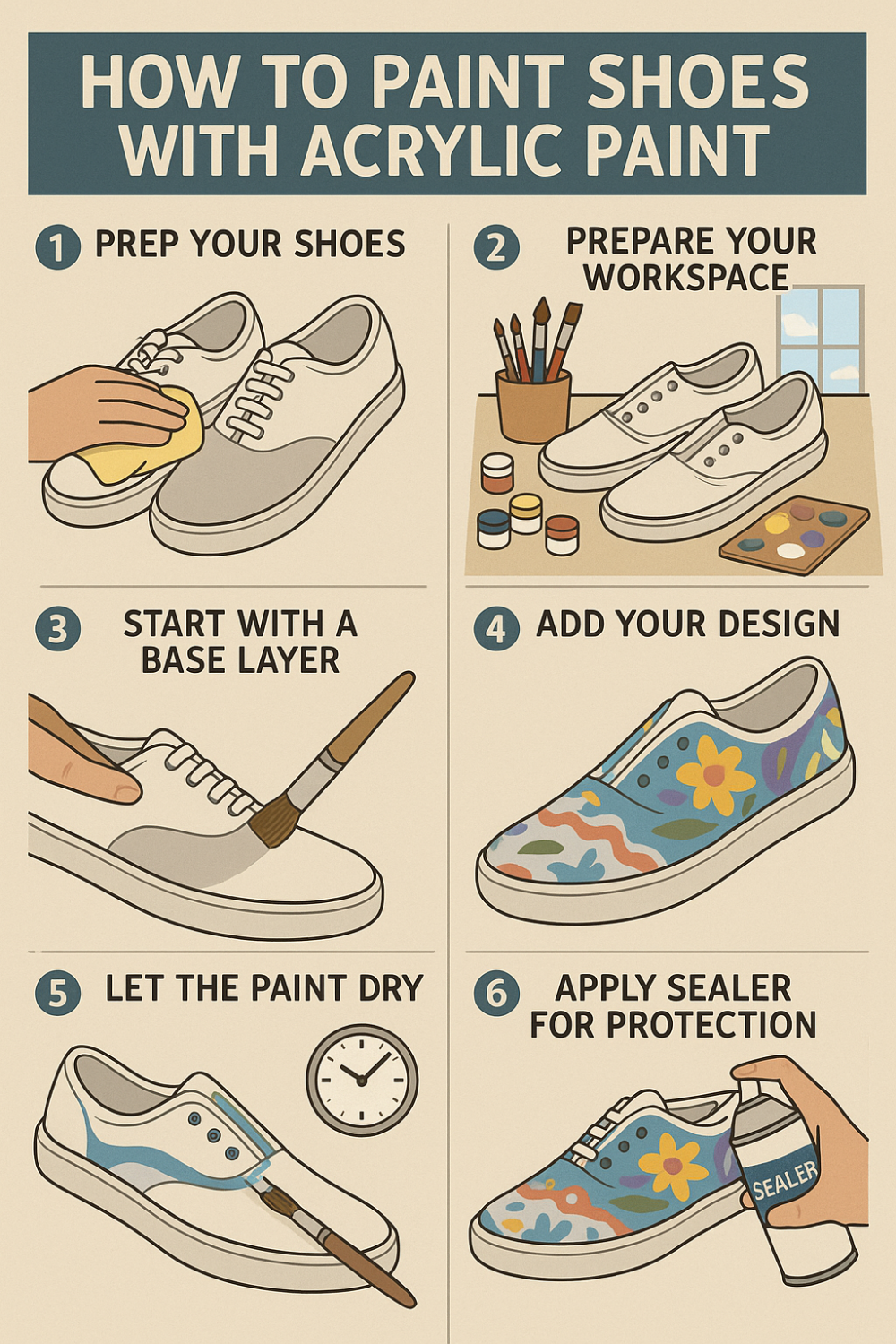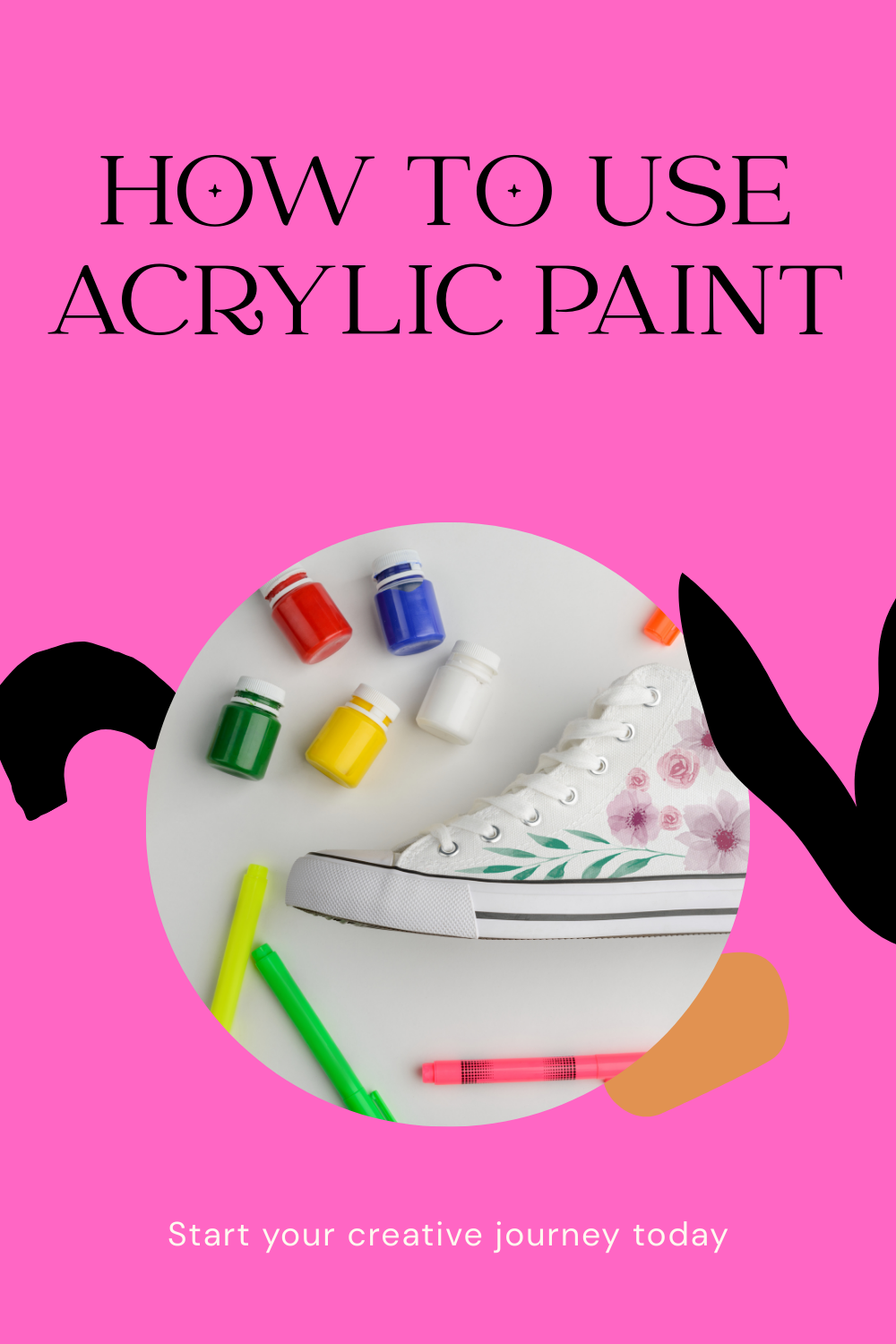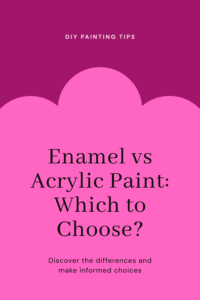Have you ever looked at a plain pair of shoes and thought, “I could make these so much cooler”? Whether it’s a pair of old sneakers gathering dust in the back of your closet or a fresh new set of canvas shoes, acrylic paint can turn them into wearable art. I’ve been there, too.
After stumbling upon a tutorial a few years ago, I decided to experiment with painting shoes using acrylics and I’ve never looked back since.
In this article, I’m going to walk you through everything you need to know about using acrylic paint on shoes. From choosing the right materials to cleaning up your masterpiece,
I’ll share some insider tips, common mistakes to avoid, and even some creative ideas to spark your next DIY project. So, if you’re ready to step up your fashion game, keep reading!

Materials You’ll Need
Before you start splashing paint on your shoes, let’s talk about the supplies you’ll need. Trust me, having the right materials can make a world of difference in the outcome of your project. Here’s what you’ll need:
| Material | Purpose |
| Acrylic Paint | The main product for painting your shoes. Choose high-quality, fabric-safe paints for durability. |
| Paint Brushes | Small, medium, and fine-tip brushes for detailed work and broad strokes. |
| Painter’s Tape | For creating clean edges or masking off areas you don’t want to paint. |
| Shoe Prep Cleaner | To clean the shoes before painting and remove dirt, oils, or other debris. |
| Sealer | To protect the finished artwork and add longevity. Consider a spray or brush-on sealer. |
| Water & Sponge | To clean the brushes between colors and keep them in good condition. |
| Palette | For mixing paint colors if needed. |
| Paper Towels | To wipe excess paint or correct mistakes during the process. |
Step-by-Step Guide to Painting Your Shoes with Acrylic Paint
Now that you have your materials ready, let’s dive into the steps. Don’t worry if you’ve never painted shoes before this guide will take you through it all. I’ll share some personal tips along the way to help you avoid common mistakes and make the process more enjoyable.
Step 1: Prep Your Shoes
The first step in this process is prepping your shoes. Whether you’re working with canvas sneakers, leather shoes, or boots, cleaning them is essential. Any dirt, dust, or oils can prevent the paint from adhering properly, leading to uneven coverage or peeling.
- Clean Your Shoes: Use a shoe cleaner or a mixture of water and mild soap to clean your shoes thoroughly. If they have any dirt buildup, use a soft brush or cloth to scrub them off.
- Dry the Shoes Completely: Make sure the shoes are fully dry before you start painting. Moisture can cause the paint to react poorly and may even cause smudging.
- Tape Off Areas: If you want clean, sharp edges or if there are parts of the shoes you don’t want to paint (like the soles), use painter’s tape to mask those areas.
Step 2: Prepare Your Workspace
Set up a clean, well-lit workspace where you can comfortably work on your shoes. A flat surface like a table or desk works best, and you’ll want to cover it with some newspaper or a plastic drop cloth to protect it from spills.
- Work in a Ventilated Area: Acrylic paint can have a strong odor, so it’s a good idea to paint in a space with plenty of airflow or outside.
- Use an Easel or Holder: If you’re working on a pair of shoes with a more intricate design, consider propping them up on an easel or shoe holder to keep them steady.
Step 3: Start with a Base Layer
Once your shoes are prepped and your workspace is ready, it’s time to start painting! The first thing you’ll need to do is apply a base layer of paint. This creates a uniform background and helps subsequent layers of paint adhere better.
- Choose Your Base Color: Depending on the design you’re going for, you may want to paint the entire shoe in a single color first. White, black, or neutral colors like beige work well as base layers for most designs.
- Apply Thin Coats: Use a larger brush to apply the base coat. Apply thin layers, and let each layer dry completely before applying another. This helps avoid the paint from becoming too thick or clumpy.
Step 4: Add Your Design
Here’s where the fun begins! After your base layer has dried, you can start adding your design. Whether it’s geometric shapes, nature-inspired patterns, or even a custom logo, this is where you can really get creative.
- Start with Light Colors: If you’re planning to add multiple colors, start with the lighter ones. It’s easier to paint over lighter colors with darker ones, but not vice versa.
- Use Fine Brushes for Detail: For intricate designs or detailed work, switch to a fine-tip brush. Acrylics are perfect for details because they can be applied in layers and offer crisp, clean lines.
- Take Your Time: Don’t rush the process. If you’re doing something complex, like a gradient effect or multiple layers, it’s important to give each layer time to dry before moving on to the next.
Step 5: Let the Paint Dry
Once your design is complete, give the shoes plenty of time to dry. I recommend leaving them for at least 12 hours to ensure that all the layers are fully set.
- Avoid Touching the Paint: As tempting as it may be to admire your work right away, avoid touching the painted areas until they’re dry to the touch.
- Check for Touch-Ups: Once the paint has dried, inspect the shoes for any areas that may need touch-ups or additional layers of paint.
Step 6: Apply Sealer for Protection
To make sure your design stays intact and lasts through wear and tear, it’s essential to apply a sealer. This helps protect the paint from scratches, fading, or peeling.
- Use a Clear Acrylic Sealer: Choose a sealer that is compatible with acrylic paint and appropriate for the material of your shoes. There are spray-on sealers that offer an even coat without brushing on additional paint.
- Apply Several Coats: Apply a thin, even layer of sealer, and allow it to dry completely before applying additional coats. Two to three layers should be sufficient.
Common Mistakes to Avoid When Painting Shoes
Even the most seasoned DIYers can make mistakes when painting shoes. Here are some of the most common missteps and how to avoid them:
- Using the Wrong Paint Type: Not all paints are suitable for shoes. Be sure to use acrylic paints that are designed for fabric or leather to ensure proper adhesion.
- Skipping the Prep Work: I’ve learned the hard way that skipping the cleaning and prep step can cause your paint to crack or peel off later. Never skip this step, no matter how eager you are to start painting!
- Not Letting Layers Dry Properly: If you try to add a new layer of paint before the previous one has dried, the colors may mix and create unwanted results. Be patient and let each layer dry before moving on.
- Using Too Much Paint: Applying thick layers of paint can lead to cracks and uneven coverage. Always apply thin, even coats and build up the paint gradually.
- Not Using a Sealer: Without a sealer, your artwork will quickly fade or peel off. It’s one of the most important steps in the process, so don’t forget it!
Creative Ideas for Painting Your Shoes
Now that you know the basics of painting shoes, let’s get those creative juices flowing! Here are some fun and unique ideas for your next DIY shoe project:
- Floral Patterns: Create beautiful, nature-inspired designs using bright, colorful flowers. This design works especially well on white or neutral-colored shoes.
- Geometric Designs: If you love clean lines and modern aesthetics, geometric patterns with bold, contrasting colors could be your thing.
- Personalized Messages: Paint a meaningful quote, your favorite lyric, or even a motivational message on your shoes to make them truly your own.
- Animal Prints: Leopard spots, zebra stripes, or even a cool owl design can be the perfect way to express your wild side.
- Gradient Effects: Create a smooth, ombre effect by blending multiple shades of paint to transition from one color to another.
Conclusion: Get Ready to Rock Your Custom Painted Shoes
Painting shoes with acrylics is a fun and creative way to breathe new life into an old pair or add your personal touch to a brand-new set. With the right materials, patience, and creativity, the possibilities are endless. Whether you’re designing for yourself or as a gift, custom-painted shoes are sure to be a conversation starter.
So, grab your brushes, pick your favorite colors, and let your imagination run wild. Don’t forget to share your creations in the comments below I’d love to hear about your designs! Have fun, and happy painting!
FAQs
Q: Can I use acrylic paint on leather shoes?
Yes! Acrylic paint works well on leather shoes, but it’s important to use a leather-prep product and a sealer afterward to ensure longevity.
Q: How long does it take for acrylic paint to dry on shoes?
Drying times vary depending on how many layers of paint you’ve applied. Typically, you should let each layer dry for 30 minutes to 1 hour before applying another. However, the final drying time after all layers are complete can be 12 hours or more.
Q: Can I wash my painted shoes?
It’s best to hand wash your painted shoes to avoid damaging the design. Use a soft cloth and mild detergent to clean them. Be gentle and avoid soaking them in water.
Q: How can I make my painted shoes waterproof?
You can make your painted shoes water-resistant by applying a waterproof sealer or fabric protector after the paint has dried. This will help protect your artwork from water damage.


